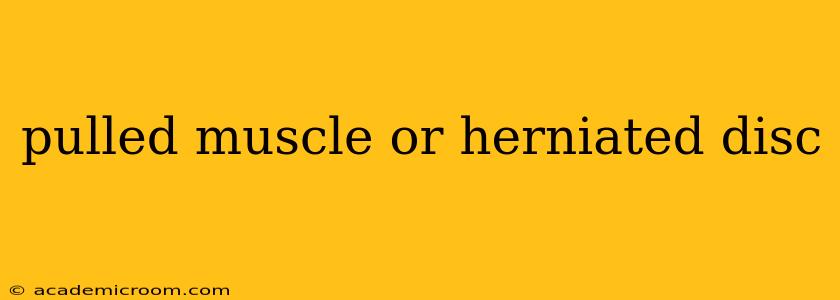Experiencing lower back pain? It's a common problem, but distinguishing between a pulled muscle and a herniated disc is crucial for effective treatment. While both can cause significant discomfort, they have different underlying causes and require different approaches to recovery. This comprehensive guide will help you understand the key differences, potential symptoms, and appropriate treatment options for both conditions.
What is a Pulled Muscle?
A pulled muscle, also known as a muscle strain, occurs when muscle fibers are overstretched or torn. This often happens during strenuous activity, sudden movements, or repetitive strain. The severity of a pulled muscle can range from mild discomfort to debilitating pain, depending on the extent of the damage. Common locations for pulled muscles in the back include the muscles surrounding the spine and those connecting the spine to the legs.
What is a Herniated Disc?
A herniated disc, also known as a slipped or ruptured disc, occurs when the soft, gel-like center of an intervertebral disc pushes through a tear in the tougher outer layer. These discs act as cushions between the vertebrae in your spine. A herniation can put pressure on nearby nerves, leading to pain, numbness, tingling, and weakness in the legs or arms, depending on the location of the herniation.
Pulled Muscle vs. Herniated Disc: Key Differences in Symptoms
While both conditions can present with lower back pain, there are some key differences in the symptoms:
Pulled Muscle Symptoms:
- Localized pain: The pain is typically focused on the affected muscle.
- Muscle spasms: Tightness and spasms in the affected muscle are common.
- Pain with movement: Pain worsens with specific movements that engage the injured muscle.
- Tenderness to the touch: The affected muscle area is usually tender when pressed.
- Gradual onset: Pain often develops gradually after an activity.
Herniated Disc Symptoms:
- Radiating pain: Pain often radiates down the leg (sciatica) or arm, following the path of the affected nerve.
- Numbness and tingling: Numbness, tingling, or weakness in the affected limb is common.
- Weakness in limbs: Difficulty lifting or moving the affected leg or arm.
- Sudden onset: Pain can be sudden and severe, particularly after a specific incident like lifting a heavy object.
- Specific posture aggravates pain: Certain postures may dramatically increase pain.
How are Pulled Muscles and Herniated Discs Diagnosed?
Diagnosis usually begins with a thorough physical examination by a doctor or physical therapist. They will assess your range of motion, palpate for tenderness, and inquire about your medical history and the circumstances surrounding the onset of pain. Imaging tests, such as X-rays, MRIs, or CT scans, may be necessary to confirm the diagnosis, especially in the case of a suspected herniated disc.
How are Pulled Muscles and Herniated Discs Treated?
Treatment for both pulled muscles and herniated discs depends on the severity of the condition. Mild cases may respond well to conservative treatments, while more severe cases may require more aggressive interventions.
Treatment for Pulled Muscles:
- Rest: Avoiding activities that aggravate the pain is crucial.
- Ice: Applying ice packs to the affected area can reduce inflammation and pain.
- Heat: Heat therapy can help relax muscles and relieve pain after the initial inflammation subsides.
- Over-the-counter pain relievers: Medications like ibuprofen or acetaminophen can help manage pain and inflammation.
- Physical therapy: Targeted exercises can help strengthen the muscles and improve flexibility.
Treatment for Herniated Discs:
- Pain management: Over-the-counter pain relievers, prescription pain medications, or even nerve blocks may be used.
- Physical therapy: A tailored exercise program can help strengthen core muscles, improve posture, and reduce pain.
- Epidural steroid injections: These injections can reduce inflammation and pain in the affected area.
- Surgery: In severe cases, surgery may be necessary to repair the herniated disc.
What are the long-term consequences of a pulled muscle and herniated disc?
Most pulled muscles heal completely with appropriate rest and conservative treatment. However, neglecting a pulled muscle could lead to chronic pain or recurring injuries.
A herniated disc may resolve spontaneously in some cases, but others require ongoing management. Untreated herniated discs can cause persistent pain, nerve damage, and in severe cases, lead to chronic disability.
Can a pulled muscle lead to a herniated disc?
While not a direct cause-and-effect relationship, repetitive strain or improper healing from a pulled muscle could potentially contribute to increased stress on the intervertebral discs, increasing the risk of herniation over time. This is not always the case, but it highlights the importance of proper treatment and rehabilitation for muscle strains.
When should I see a doctor for back pain?
Seek immediate medical attention if you experience:
- Severe, sudden back pain.
- Back pain accompanied by fever or chills.
- Numbness or weakness in your legs or arms.
- Loss of bowel or bladder control.
- Pain that doesn't improve after a few weeks of home treatment.
This information is for general knowledge and does not constitute medical advice. Always consult with a healthcare professional for diagnosis and treatment of any medical condition.
